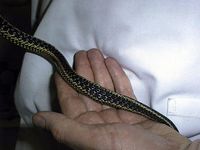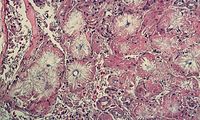Gout - Reptiles
Introduction
Gout is a metabolic disease where there is a precipitation of urate crystals in tissue. There are two types of gout in animals.
- In primary gout there is an overproduction of uric acid related to an innate metabolic problem.
- In secondary gout, acquired disease interferes with the uric acid metabolism. Terrestrial reptiles are predisposed to secondary gout since nitrogenous waste is excreted as uric acid.
For more information on excretion, see Lizard and Snake Excretion.
Snakes
In snakes, kidney disease often leads to the development of a visceral gout where uric acid crystals (tophi) are deposited in subcutaneous and internal tissues.
Examination
History may show poor husbandry including limited access to water. Snakes often present as anorexic and lethargic. Often if kidney disease is involved there is a palpable lump in the caudal third.
For a differential diagnosis list of other causes of lumps in the body, see Snake Lumps and Bumps.
Diagnosis
The diagnosis of gout may be suspected on history and physical examination. Biochemistry may indicate a hyperuricaemia. Sometimes radiography is useful if calcium is deposited with the urate crystals. Biopsy of any lumps may be useful. A definite diagnosis is the demonstration of tophi in diseased tissue.
For more information on physical examinations, see Snake Physical Examination.
For more information on biopsy collection, see Specimen Collection and Evaluation.
Treatment
Supportive treatment especially aimed at rehydration may be useful but gout carries a poor prognosis. Previously allopurinol (a xanthine oxidase inhibitor that decreases formation of uric acid) has been recommended as a treatment of hyperuricaemia in reptiles and birds but in fact appears to be of little use. Other drugs such as uricases (enzymes involved in the degradation of uric acid to allantoin) may be more useful.
For more information, see Snake Supportive Care.
Prevention
Any bouts of dehydration will predispose to the development of gout so good husbandry is important in prevention. Vets should ensure adequate hydration of reptiles prior to any drug therapy but especially when using nephrotoxic drugs.
For more information on good husbandry practices, see Snake Husbandry.
Other Reptiles
Gout is a common condition in various species of captive reptiles. High-protein or poor quality protein diets, dehydration and renal disease are all thought to contribute to its development - as they increase levels of uric acid. Urate crystals can precipitate in the joints, kidneys, and other internal organs.
Examination
There may be a history of poor husbandry, including limited access to water and the feeding of a low quality protein diet. On clinical exam, there may be swelling of the joints and the animal will appear painful and reluctant to move.
Diagnosis
The diagnosis of gout may be suspected on history and physical examination and Biochemistry may show a hyperuricaemia. Sometimes radiography is useful if calcium is deposited with the urate crystals. Biopsy of any lumps may be useful.
For more information on physical examinations, see Lizard Physical Examination.
For more information on biopsy collection, see Specimen Collection and Evaluation.
Treatment
The hydration of the reptile should be improved by providing ample water and feeding moisture-laden food such as soft fruits. If the reptile is omnivorous, levels of animal protein should be decreased. If the reptile is carnivorous, instead of decreasing levels of protein in the diet, you should ensure that the protein fed is of a high quality.
Additionally, allopurinol can be given orally on a daily basis. It decreases the quantity of urate salts produced by the liver, but does not help to remove the crystals that have already precipitated around the joints and organs, so is often of little use.
Pain relief can be provided using NSAIDs, but gastrointestinal side effects may be seen.
Prevention
Good husbandry is the best way to prevent the development of gout. Ample water, and the correct amount of high quality protein (variable according to species) should be provided for the reptile. Before the administration of any drug therapy (particularly nephrotoxic drugs) the hydration status of the animal should be checked.
| Gout - Reptiles Learning Resources | |
|---|---|
 Test your knowledge using flashcard type questions |
Reptiles and Amphibians Q&A 04 Reptiles and Amphibians Q&A 19 |
 Search for recent publications via CAB Abstract (CABI log in required) |
Snake Gout publications |
 Full text articles available from CAB Abstract (CABI log in required) |
Reptilian gout: clinical overview. Mader, D. R.; Association of Reptilian and Amphibian Veterinarians, Chester Heights, USA, Proceedings of the Association of Reptilian and Amphibian Veterinarians, 14th Annual Conference, New Orleans, Louisiana, USA, 14-18 April, 2007, 2007, pp 110-115, 4 ref. - Full Text Article |
References
Frye, FL & Williams, DL (1995) Self-Assessment Colour Review - Reptiles & Amphibians Manson
Merck & Co (2009) The Merck Veterinary Manual (Ninth Edition), Merial
| This article has been peer reviewed but is awaiting expert review. If you would like to help with this, please see more information about expert reviewing. |
Error in widget FBRecommend: unable to write file /var/www/wikivet.net/extensions/Widgets/compiled_templates/wrt694d4a5a9ccd21_24148938 Error in widget google+: unable to write file /var/www/wikivet.net/extensions/Widgets/compiled_templates/wrt694d4a5aa707d7_07134812 Error in widget TwitterTweet: unable to write file /var/www/wikivet.net/extensions/Widgets/compiled_templates/wrt694d4a5aae6cd4_86116466
|
| WikiVet® Introduction - Help WikiVet - Report a Problem |


